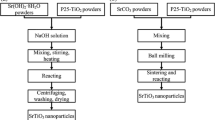Abstract
The current study aims to investigate the synthesis and formation mechanism of the carbonate-free strontium titanium oxide nanosized crystals. Monosized strontium titanium oxide nanocrystals with tailored morphology have been successfully synthesized using a novel facile synthesis pathway. The synthesis method is based on an ultrasound-assisted wet chemical processing method. Nanocrystals are characterized and observed by X-ray diffraction, field-emission scanning electron microscopy, and high-resolution transmission electron microscopy techniques. It was found that the ultrasonication accelerates the formation of stoichiometric strontium titanium oxide nanocrystals. Furthermore, the results show that very fine nanocrystals with an average size of about 4.8 nm and a narrow size distribution are obtained when ultrasonication is applied to the reaction mixture. As the most important outcome of this research, carbonate-free strontium titanium oxide nanocrystals are synthesized at a very low temperature of 323 K (50 °C). This temperature is much lower than the temperature required for synthesis of strontium titanium oxide nanocrystals in the similar works. This advantage has been reached, thanks to the applied modifications leading to complete removal of carbon from reaction mixture during synthesis. Moreover, formation mechanism of the nanocrystals synthesized in this work is disclosed.








Similar content being viewed by others
References
R. Ashiri, A. Nemati, M. Sasani Ghamsari, S. Sanjabi, and M. Aalipour: Mater. Res. Bull., 2011, vol. 46, pp. 2291–95.
F. Davar, M.R. Loghman-Estarki, and R.Ashiri: J. Ind. Eng. Chem., DOI: 10.16/j.jiec.2014.05.002.
[3] R. Ashiri, A. Moghtada, A. Shahrouzianfar and R. Ajami: J. Am. Ceram. Soc., 2014, vol. 97, pp. 2027-31.
[4] T.X. Wang and W.W. Chen: Mater. Lett., 2008, vol. 62, pp. 2865-7.
[5] F. Davar, M.R. Loghman-Estarki, M. Salavati -Niasari and R. Ashiri: Int. J. Appl. Ceram. Technol., 2014, vol. 11, pp. 637-44.
R. Ashiri, A. Nemati and M. Sasani Ghamsari: Ceram. Int., 2014, vol. 40, pp. 8613-9.
R. Ashiri, A. Nemati, M. Sasani Ghamsari, and H. Adelkhani: J. Non-Cryst. Sol., 2009, vol. 355, pp. 2480–84.
[8] R. Ashiri: Metall. Mater. Trans., 2014, vol. 45B, pp. 1472-83.
[9] R. Ashiri: Metall Mat Trans., 2014, vol. 45A, pp. 4138-54.
[10] R. Ashiri: Metall Mat Trans, 2012, vol. 43A, pp. 4414-26.
R. Ashiri, A. Nemati, M. Sasani Ghamsari, and M.M. Dastgahi: J. Mater. Sci.: Mater. Electron., DOI: 10.1007/s10854-014-2312-5.
[12] J.Q. Zheng, Y.J. Zhu, J.S. Xu and B.Q. Lu: Mater. Lett., 2013, vol. 100, pp. 62-5.
[13] C.N. George, J.K. Thomas and R. Jose: J. Alloy. Compd., 2009, vol. 48, pp. 711-5.
[14] Sh. Zhang and J. Liu: Mater. Sci. Eng., 2004, vol. 110B, pp. 11-7.
[15] L.F.D. Silva and L.J.Q. Maia: Mater. Chem. Phys., 2011, vol. 125, pp. 168-73.
[16] H.L. Li and Z. N. Du: Mater. Lett., 2010, vol. 64, pp. 431-4.
[17] H. Cui, M. Zayat and D. Levy: J. Non-Cryst. Solid., 2007, vol. 353, pp. 1011-6.
[18] T.J. Mason and J.P. Lolimer: Applied Sonochemistry. Wiley-VCH Verlag, U.K., 2002.
[19] M. Xu and Y.N. Lu: J. Am. Ceram. Soc., 2006, vol. 89, pp. 3631-4.
[20] M. Xu and Y.N. Lu: Powder. Technol., 2006, vol. 161, pp. 185-9.
[21] R. Ashiri: Vib. Spec., 2013, vol. 66, pp. 24-9.
[22] E. Bacha and Ph. Deniard: Thin. Solid. Films., 2011, vol. 519, pp. 5816-9.
[23] Y.G. Adewuyi: Ind. Eng. Chem. Res., 2001, vol. 40, pp. 4681-715.
[24] K.S. Suslick: Science, 1990, vol. 247, pp. 1439-45.
[25] E.B. Flint and K.S. Suslick: Science, 1991, vol. 253, pp. 1397-9.
R. Ashiri, R. Ajami, and A. Moghtada: Int. J. Appl. Ceram. Technol., DOI: 10.1111/ijac.12315.
Author information
Authors and Affiliations
Corresponding author
Additional information
Manuscript submitted June 30, 2014.
Rights and permissions
About this article
Cite this article
Ashiri, R., Moghtada, A. Carbonate-Free Strontium Titanium Oxide Nanosized Crystals with Tailored Morphology: Facile Synthesis, Characterization, and Formation Mechanism. Metall Mater Trans B 45, 1979–1986 (2014). https://doi.org/10.1007/s11663-014-0213-x
Published:
Issue Date:
DOI: https://doi.org/10.1007/s11663-014-0213-x




